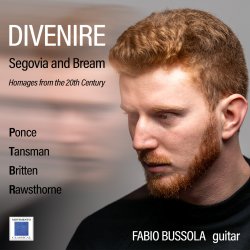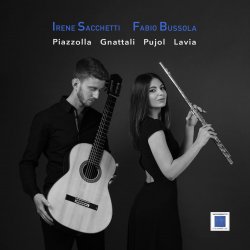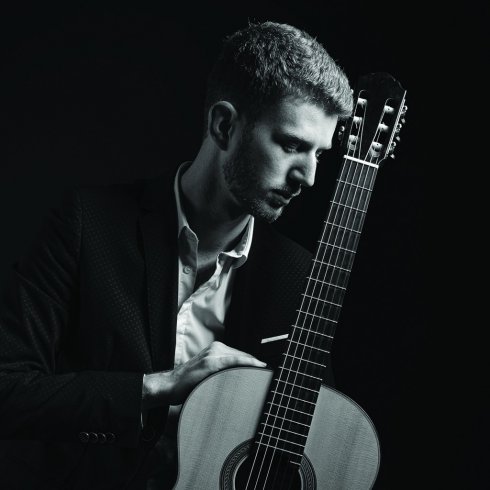

Divenire
The union between an artist and a record company always stems from a harmony of vision and common goals. In this case, the shared decision to release a CD that departs from traditional monographic collections is a wise and admirable choice.
Monographic collections or full-length recordings dedicateci to a single composer are certainly important, especially when the goal is to bring worthy unpublished works to light. lndeed , these projects contribute to greater knowledge and diffusion of the repertoire, providing an indispensable reference point tor scholars and enthusiasts. However, their enjoyment can be less immediate tor the listener, as it risks turning the CD into an object closer to an encyclo pedic resource than an engaging musical experience.
Prolonged listening to a repertoire entirely devoted to a single author, however fa scinating, can generate a certain monotony and fatigue, reduc ing emotional impact and the ability to surprise. For this reason, the choice of a more varied program, one that juxtaposes different composers or travels along heterogeneous stylistic and thematic routes, proves to be a winning strategy tor maintaining active attention and stimulating a more dynamic and compel ling listening experience.
Divenire is inspired by the idea of rediscovering "old-time" listening, evoking the historical Guitar Recital, which was popular unti! the early 1990s. A path that highlights and celebrates masterpieces tor guitar composed in the "short century" also thanks to the heterogeneous choice of authors.
The strength of Divenire lies precisely in this choice: to present the experience of the traditional guitar recital, offer ing a nuanced listening experience, full of significant works, capable of conveying the variety and beauty of 20th-century guitar music.
This kind of old-style approach requires a forward-looking vision on the part of the record company which is capable of recognizing the intrinsic value of the work beyond current trends. Likewise, the artist finds in this collaboration the freedom to express himself fully , away from constraining themes.
Manuel Maria Ponce (Fresnillo, Dee. 8, 1882- Mexico City, Aprii 24, 1948) was one of Mexico's most important com posers, known tor his ability to fuse the European musical tradition with the sounds and rhythms of Latin American folklore.
The Variations sur "Folia de Espana" et Fugue were composed in 1930 and dedicateci to Andrés Segovia.
The "Folia" theme is a melody that has spanned centuries and across cultures, becoming a veritable "playground" tor countless variations and reworkings by composers of different eras.
Through this thematic elaboration, Ponce intended to establish a dialogue between the Spanish tradition - which profoundly influenced European music - and his own innovative outlook, full of coloraturas, exotic rhythms, and inter national study experiences.
This work explores the expressive potential of the guitar through the use of an ancient moti!, enriching it with modem harmonic and rhythmic writing. Alternating between variations, the monumental final fugue allows the composer to expose both the interpretive freedom and emotional immediacy of the theme and its variations as well as the contra puntai discipline and formai complexity of the fugue . The twenty variations present a path ot transtormation tor the theme in which ornamentations and rhythmic transtor mations enrich the melody with embellishments, dynamic changes and modulations thai introduce different harmonic colorations.
The alternationbetween lyrical passages and the more virtuosic moments highlights the dual soul ot the work: on one hand the link with tradition and on the other the search tor a new stylistic synthesis.
The tugue, or it preterred, the variation in tugue torm, is the climax ot the composition, offering a strie! contrapuntal structure thai contrasts with the expressive treedom ot the variations.
Noctumal atte,John Dowland, Op. 70, composed by Benjamin Britten (Lowestoft, England, Nov. 22, 1913 - Alde burgh, Dee. 4, 1976) in 1963 lor guitarist Julian Bream and first performed in 1964 at Aldeburgh, represents a masterpiece of the 20th-century guitar repertoire.
The work is notable tor its innovative structure which subverts the traditional form ot the theme with variations. lnstead of beginn ing with the therne and proceeding with the variations, Britten reverses the process: the work un folds through a series of eight variations thai lead progressively toward the final theme: Come, Heavy S/eep by John Dowland (1563-1626).
Each variation explores a different atmosphere and guitar technique:
1. Musingly - A meditative introduction, with open intervals and raretied sonorities.
2. Very Agitateci - Dynamic contrast with irregular rhythms and strong accents.
3. Restless - Growing tension with syncopated notes and broken phrasing.
4. Uneasy - Darker atmosphere with descending chromatic lines.
5. March-like - Stiff, punchy rhythm, almost martial.
6. Dreaming - An ethereal episode with suspended harmonies.
7. Gently Rocking - Gentle oscillations,evoking a cradle movement.
8. Passacaglia - A dramatic climax, preparing the return of the theme.
The work concludes with the presentation of Dowland's theme in an atmosphere of peace and resolution,emphasiz ing the concept ot rest alter the torment of the previous variations.
The Noctumal is noi only a work ot extraordinary technical and formai complexity bui also has a protound reflection on the duality ot lite and death, as well as tension and resolution. lts reverse structure emphas izes the idea ot a return to the origins, an inner journey thai ends in the rediscovery of simplicity and inner stillness.
lt can be said, without fear ot contradiction, thai the two compositions by Ponce and Britten are masterpieces of the guitar repertoire; they have no tempora! boundary thai can be linked to a century, context, or torm. Nonetheless, they represent some ot the highest achievements ever reached in guitar writing, tram both compositional and technical sides.
The other two compositional gems on this CD are Varlatlons sur un thème de Scrlabln by Polish composer Alex andre Tansman (L6dz, June 12, 1897 - Paris, November 15, 1986) and Elegy by English composer Alan Rawst horne (Haslingden, May 2, 1905 - Cambridge, July 24, 1971).
Tansrnan's Variations is a refined tribute to the great Russian composer Aleksandr Nikolaevic Skrjabin, elegantly and masterfully developing the originai thematic materiai (Prelude No. 4 tram the 5 Preludes op. 16) through a series of stylistic transformations that reveal the depth of the composer's harmonic and timbrai inventiveness. Tansman, known lor his sophisticated musical language that blends elements of the French tradition with neoclassica! and jazz influences, constructs a sequence of variations that explore the theme's expressive potential with great timbrai and formai sensitivity.
Rawsthome's Elegy, dedicateci to Bream, stands out as the only piece on the program that does not adopt the varia tion form. In this composition, the English musician brings to life a melancholy and meditative atmosphere, charac terized by intense melodie lines and the expressive use of harmonies. Rawsthome, whose writing is in the groove of 20th-century British music, with influences ranging from Ralph Vaughan Williams to Igor Stravinsky, conceives Elegy as a moment of introspection and lyricism, where the melody unfolds in a continuous flow of timbrai changes. The sudden death of the English compose, in 1971 left the work unfinished.
The finalewas drafted byJulian Bream from measure 131 and ittakes up theopening section byvarying it and clev erly inserting the few notes left by Rawsthome lor the close of the composition, creating an artistic whole in keeping with the composer's style.
The common feature of the tour compositions presented, i.e., the common thread of the CD is easily identified in the dedicatees of these works: Andrés Segovla (1893-1987) and Jullan Bream (1933-2020) the two most import ant guitarists in modem and contemporary history.
To fully understand the connection between Segovia and Bream, it is necessary to explore not only their persona! and artistie relationship, but more importantly their complementary impact on the development of the classica! Guitar in the 20th century. Segovia is rightly considered the "father" of the modem classica! guitar. His primary aim was to transform the guitar from a popular instrument to a leading player in concert halls, on a par with the piano and violin. His artistic goals therefore were aimed to revalue its repertoire by means of a traditional literature through transcriptions (Bach, Scar latti) and new commissions. lt is precisely through the commission and direct contaci with Segovia that, in this specific case, Ponce and Tansman will contribute numerous compositions to enrich the guitar repertoire.
The similarities between Segovia and Bream are found in the role they both played in bringing the guitar to an inter national audience, elevating it to the level of soloist in classica! music concerts. The two have expanded the guitar repertoire, commissioning works from contemporary composers and performing a vast number of pieces both originai lor the guitar and arrangements of works for other instruments.
The ditferences between the two are essentially attributable to the generational gap. Metaphorically speaking, Segovia built the house of the classica! guitar, while Bream added stylistically new rooms to it, transforming it into an even richer and more multifaceted piace. The relationship between Segovia and Bream represents a dialectic be tween tradition and innovation: without Segovia, Bream would have found it difficult to emerge, but without Bream, Segovia's vision would have remained confined to a more conservative dimension. Together, tey transformed the classica! guitar into a dynamic and broad musical universe.



Fabio Bussola
Born in Bergamo in 1998, he began studying guitar at the age of nine with Ivan Bracchi, then attended the “P. Secco Suardo” music high school in Bergamo with the guitarist and composer Giovanni Podera and the “Gaetano Donizetti” Conservatory of the same city with Luigi Attademo. From 2015 to 2019 he studied with Andrea Dieci and Bruno Giuffredi in the “Giulio Regondi” guitar Academy in Milan. In 2020 he graduated with the highest marks, honors and special mention at the “Guido Cantelli” Conservatory of Novara. He has participated in master classes with internationally renowned teachers such as Giulio Tampalini, Frédéric Zigante, Javier Riba, Andrea De Vitis, Christian Saggese, Lucio Matarazzo, Massimo delle Cese and Marco Tamayo. In addition to performing in Italy and abroad as a soloist and in various chamber formations, he won more than twenty national and international guitar competitions, including the first prize at the 12° edition of “Città di Voghera” international competition, the first prize for two consecutive editions in “Città di Favria” international competition and the first prize with special mention in “Città di Tradate” guitar competition. In 2015 he was awarded the 29° “Lino Barbisotti” scholarship edition in Bergamo, in 2016 he won the “Mauro Fantinelli” international interpretation award and in 2016-2017, for two consecutive editions, he won with the flutist Irene Sacchetti the “Music and Nature” chamber music award in Switzerland. Since 2018 he has been the winners of several prizes and competitions, including the first prize at “Giorgio e Aurora Giovannini” guitar competition in Reggio Emilia, the first prize for two consecutive editions in “Festival Corde d’autunno” international competition in Milan, the first prize in “G. Marziali” competition in Seveso and the first prize in “La chitarra volante” national competition in Brescia. In 2019 he was awarded the “Francesco Vaccari” scholarship and he played in many guitar festivals, including the prestigious “Il Mondo della Chitarra” guitar festival in Novara, which every year hosts important international artists. In 2019 and 2020 he won for two consecutive editions the “Seicorde Academy” award, assigned by the Masters Andrea Dieci, Christian Saggese, Giulio Tampalini, Marco Tamayo and Filippo Michelangeli, the “Suonare News” and “Seicorde” director. He recently took part in a “Seicorde – I Maestri della Chitarra” recording project and will record a new CD the next year. In 2020 he won the “Giancarlo Facchinetti” award for best young performer of the “Seicorde Academy”. He recorded the works of the guitarist and composer Giovanni Podera and other works dedicated to him by contemporary composers such as Luigi Artina, Kevin Swierkosz-lenart and Franco Balliana. Many of these recordings are published for the “Sinfonica” publishing house and the “ZeroCrossingRecords” label. In 2020 he released his first video for the important german label “SiccasGuitars”, brand followed for the performance publications of famous and young guitarists from all over the world. He is currently studying at the “Guido Cantelli” Conservatory in Novara with Bruno Giuffredi.
